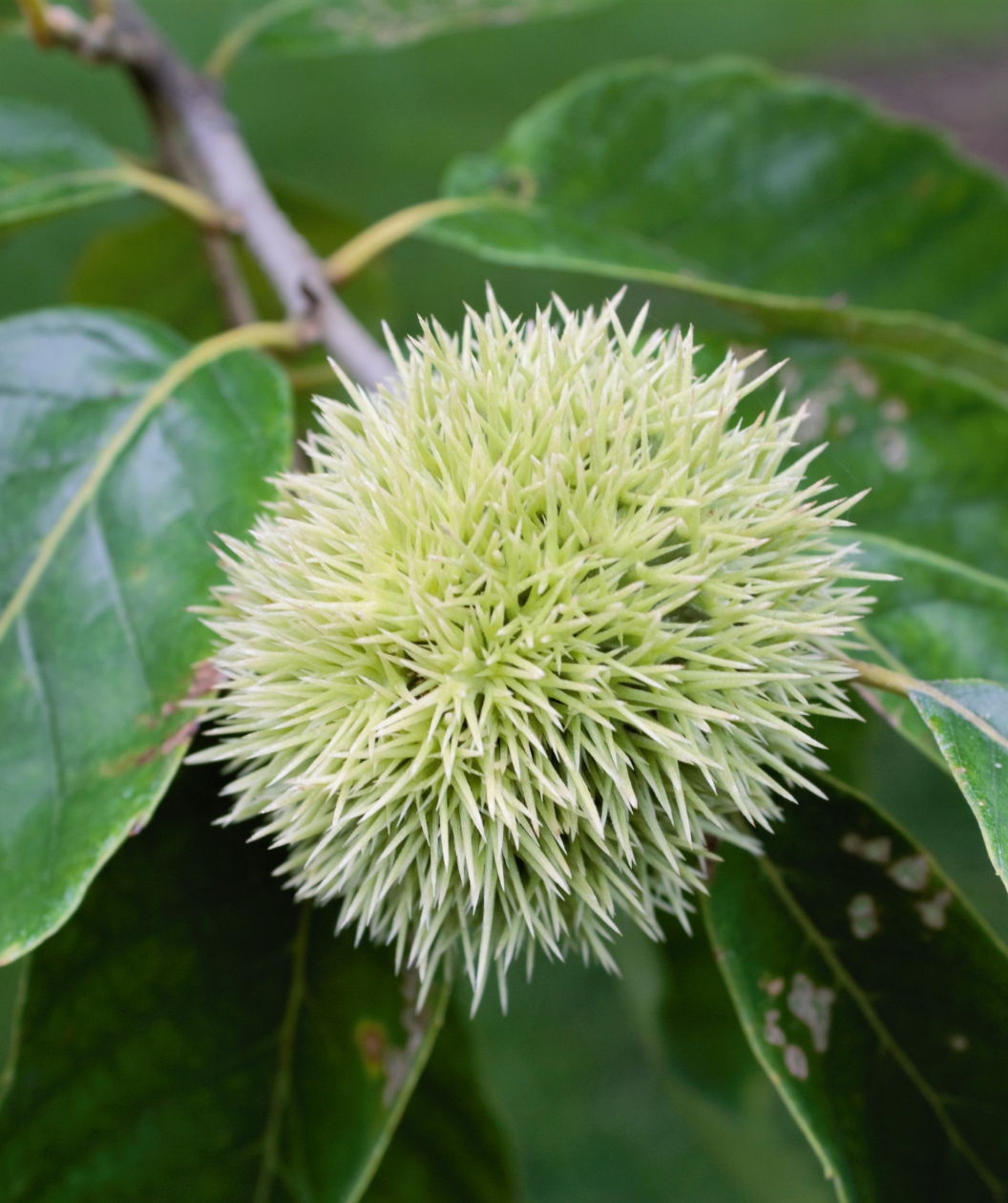

SEED GROWN CHINESE CHESTNUT FROM SELECTED AND SUPERIOR TREES
FEATURES:
- Grow your own delicious sweet chestnuts
- Fluffy and fragrant, cream-colored catkins adorn the tree in summer before morphing into chestnuts for fall harvest
- Dark, glossy green leaves turn an amber brown in fall
- Two trees are needed to ensure proper cross pollination for fruit production
- Chestnut makes a wonderful shade tree
- Blight resistance makes it a great replacement for American Chestnut
- Hand selected fresh from our grower
Growth Facts
- Hardiness Zone: 4-8
- Mature Height: 30-60' tall
- Mature Width: 20-40' wide
- Exposure: Full Sun
- Spacing: 20-40' apart
SEED GROWN CHINESE CHESTNUT FROM SELECTED AND SUPERIOR TREES
FEATURES:
- Grow your own delicious sweet chestnuts
- Fluffy and fragrant, cream-colored catkins adorn the tree in summer before morphing into chestnuts for fall harvest
- Dark, glossy green leaves turn an amber brown in fall
- Two trees are needed to ensure proper cross pollination for fruit production
- Chestnut makes a wonderful shade tree
- Blight resistance makes it a great replacement for American Chestnut
- Hand selected fresh from our grower
Growth Facts
- Hardiness Zone: 4-8
- Mature Height: 30-60' tall
- Mature Width: 20-40' wide
- Exposure: Full Sun
- Spacing: 20-40' apart
Why plant Chinese Chestnut (improved) Treeling?
Improved Chestnuts are medium to large understory tree with broad crown. Native trees have two to three small fruits (2-3 cm diameter each) in each spiny cupule. Chinese chestnuts grown from seed of superior selections readily cross-pollinates with other species of chestnut to form hybrids.
In the early days of the United States, millions of American Chestnut Trees grew across the land, from Michigan to Maine and south to Mississippi and northwestern Florida. The largest specimens were over 100 feet tall and had trunks 12 feet thick. The durable wood supplied people with the material to make furniture, railway ties, and utility poles. Then, in 1904, a deadly Chestnut blight from China appeared at the Bronx Zoo. By the time Nat King Cole was singing about roasting chestnuts in 1946, most of the country’s Chestnut Trees had fallen victim. We offer seedlings from mature, surviving Chestnut Trees in northwestern Illinois in an effort to help get this glorious species reestablished!
How to use Chinese Chestnut (improved) Treeling in the landscape?
Don't let this understory tree fool you; this Chinese Chestnut variant will produce 2-3 nuts per spinous capsule. Even though Improved is an understory tree, this tree will still grow to a medium-large height, making it an excellent shade tree to include in your landscape. To ensure that you have decent chestnut harvests, you'll want to plant another Chinese Chestnut nearby to cross-pollinate with.
Planting Zones
Hardiness Zone: 4-8
How To Plant Chinese Chestnut (improved) Treeling
Improved Chestnut appreciates good, rich, moist, well-drained soil and plenty of sunshine. Provide regular irrigation. Chestnuts are encased in prickly, sea urchin–like pods, so you’ll want to keep this tree away from patios, pools, sidewalks, and other places where bare feet may wander. In rural areas, semi-wild spaces are ideal, as local wildlife like turkeys, jays, and grouse will love to share in the bounty. Before planting, check with your local extension office about the presence of Chestnut blight in your area and the feasibility of planting Chestnuts on your property.
How To Water
Chestnut Trees will appreciate watering deeply, and regularly during its first few years in the ground. Irrigate weekly, and especially during long dry spells or extreme heat after it’s established.
How To Fertilize
Incorporate Elements Starter Plant food granular form into the soil when planting. If planting in spring or summer, start fertilizing late fall using Elements Starter Plant food granular form on an annual basis each late fall. Continue this for the first three years to get your plant well established.
Videos
How Does Shipping Work?
Size Small, Medium, and Large plants (our Treelings, Shrubs, Bushes, and Perennials) will be shipped directly to your home by a common carrier. Ships in a plant-safe designed box within 7-12 business days.
How Does Sizing Work?
The size of our trees have nothing to do with the container size like you may find elsewhere–big doesn't mean just height - it’s also vigor, age, and overall health.. Other online retailers are going to tell you that a plant is a seven gallon, that means nothing to your tree or plant (or you.)
Our trees for sale online are graded on large, x-large, and even bigger sizes. This is because our trees are sized by their age—the higher the letter, the more mature the tree. The age determines the trees’ overall height, size of the trunk and the overall branch density.
All of these characteristics are what you should be looking for when choosing a tree for immediate impact and instant curb appeal. Our extra-large tree and plant sizes are sure to wow you and your neighbors!
See the size guides below.











